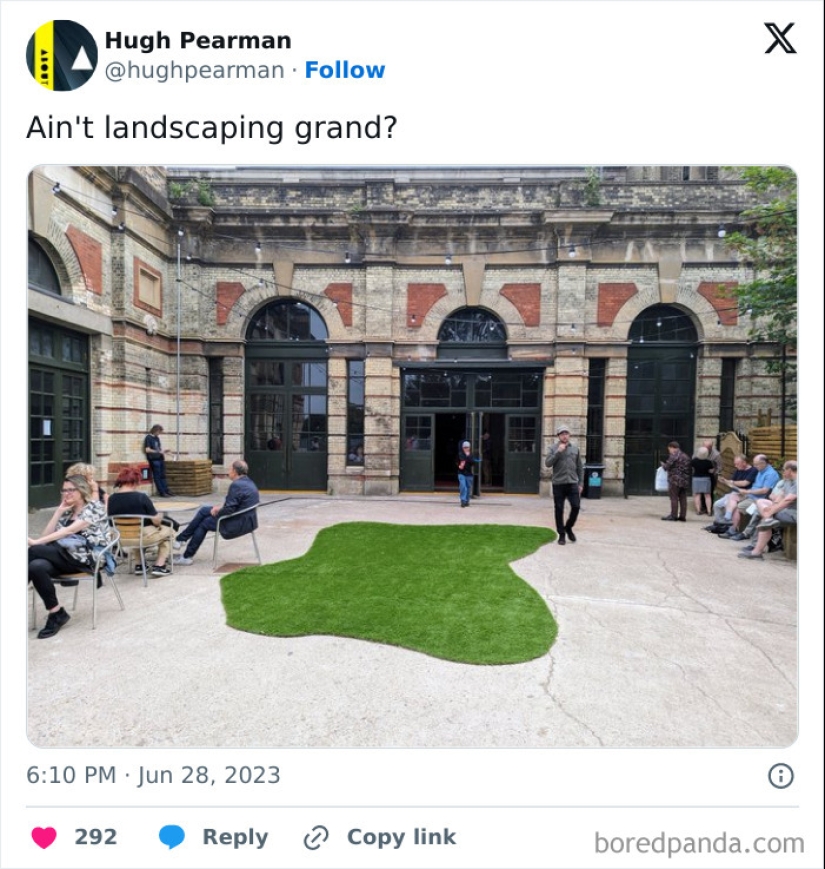10 Architects Who Did Not Think Their Projects Through And Created Eyesores
Categories: Art | Design and Architecture | People | Photo project
By Vika https://pictolic.com/article/10-architects-who-did-not-think-their-projects-through-and-created-eyesores.html“Measure twice, cut once” sounds like common sense. However, that’s easier said than done. Some ‘professionals’ are in such a hurry to get their jobs done that their results end up negatively impacting a whole bunch of people.
The ‘Bad Planning’ account on X (formerly Twitter) calls out incompetent and negligent architects, planners, surveyors, and engineers who made egregious and long-lasting mistakes. We’ve collected some of the top photos of design eyesores to show you how a failure to plan affects the entire project and everyone living near there. Scroll down to see what that looks like.
Pictolic wanted to learn more about what poor city planning looks like, so we reached out to Sweden-based urban planner and designer Luka Kodikaitė. She was kind enough to shed some light on the topic and shared her perspective on the negative impact of car-centric cities. Read on for our full interview with her.
10 PHOTOS

#1
We wanted to learn more about poor city planning and how it can negatively impact residents. According to Kodikaitė, some of the worst examples of poor city planning often prioritize cars over people.
"With the rise of the automobile, cities experienced a shift towards environments heavily reliant on cars for daily commuting, resulting in longer distances, wider roads, and increased parking space at the expense of green areas," the Sweden-based urban planner explained to Bored Panda.
"One infamous case that altered urban planning history is the clash between Jane Jacobs, a grassroots activist, and Robert Moses, a New York City urban planner, regarding the proposed construction of the Lower Manhattan Expressway. Jacobs argued against carving up inner-city communities for the sake of expressways, emphasizing the detrimental impact on neighborhoods and community life," she shared.

#2

#3
"This emphasis on car use is also reflected in the treatment of urban cycling by planners. Cyclists are often marginalized and perceived negatively in comparison to drivers. We see such hazardous examples such as bike lanes placed on high-speed roads or highways, where cyclists are extremely more vulnerable in traffic situations compared to cars."
These car-centric cities can have lots of negative consequences for the people living there, from increased air pollution and traffic congestion to ugly environments and reduced walkability.
"Another detrimental by-product of car-oriented development is the urban sprawl, leading to low-density suburbs lacking essential amenities and perpetuating car dependency while discouraging walkability," Kodikaitė told Pictolic.

#4

#5

#6
With all of this in mind, we were interested in finding out how planners and architects can become more aware of making potential mistakes or decisions with negative consequences.
"Unfortunately, in our current economic system, funding decides the quality of the projects. However, there are still ways that planners and architects can influence the outcomes within those frames," the urban planner told Bored Panda.
"One pitfall to avoid is the tendency to adopt a 'one-plan-fits-all' mentality. The same concept applied in one country or community will probably function differently when applied in a different context. An effective approach is to actively involve the community and stakeholders in the planning process. By listening to the people who will inhabit the spaces, unexpected insights can emerge, completely turning around the preconceived ideas that were initially based on well-intended, yet stereotyped, assumptions," Kodikaitė urged planners to approach these decisions from a different perspective and be more involved with the community.

#7

#8

#9
“On the other hand, in some cases, planners and architects can become too rigidly set in their old ways, adopting the ‘we’ve always done this way, and it worked just fine’ mentality without acknowledging that the current has become outdated. Examples exist in other countries which have data to prove that different models and approaches can be significantly greater, yet planners in other countries refuse to apply it, thinking it would never work on their soil," she pointed out that this sort of narrowmindedness can be detrimental to everyone.
"Lastly, in the current day’s spirit of sustainable thinking, planners ought to work with the future in mind. Designing sustainably long term involves creating adaptable spaces and structures capable of evolving alongside changing needs and circumstances. This approach minimizes resource waste and ensures long-term viability."

#10
Keywords: Architects | Design | Architecture | Design projects | House designs | Interior design | Exterior design
Post News ArticleRecent articles

Jacques-Henri Lartigue (1894-1986) is perhaps the most famous "amateur" in the history of photography. The art world discovered his ...

It turns out that an active lifestyle is useful not only for the body but for the brain. Exercise strengthens muscles and spirit, ...
Related articles

Some people constantly complain about the lack of imagination. And I think we understood what it is… Just created the Earth, ...

Looking at this photo, you might think that it is a set for a movie about aliens. But this is not a dummy at all, but a real ...

A good designer can even banal things to make a work of art. Bad — on the contrary, spoil, and even problems will create. Here ...

Most major companies profanity is not encouraged. It is considered that the profanity — it is a sign of disrespect for ...